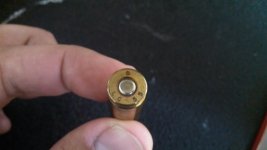Hello all,
I've been to two local gun shops and so far, it doesn't really seem like either has been much help. My grandfather was big into guns and reloading, so when he passed away almost 15 years ago, my grandmother let each grandchild pick a gun before she sold all the ones left. He had around 150 rifles and 200 or so handguns. I chose a 45 LAR Grizzly win mag. A few months later when my cousin drove out to see me, he brought all the .45 Win-Mag ammo that he could find in my grandfathers basement.
Roughly 1/2 was .45 win-mag ammo, I don't know what the other half is. The brass is around .08" too long to fit in the Grizzly. One local shop said it was .45 colt; but it doesn't have the "shoulder" to keep from going all the way through a cylinder in a revolver. The other shop says its .45 super-mag. There really isn't much info on the net about the super-mag. Anyways, I have 564 rounds of this stuff that I can't use! Hope some one can tell me what I have. On some of the brass it has L C 4 5, I don't know if those were long colts that my grandfather put on a lathe and got rid of the shoulder or what. Some of the brass it has LC55. In the picture, the .45 win-mag ammo is above the unknown ammo
I've been to two local gun shops and so far, it doesn't really seem like either has been much help. My grandfather was big into guns and reloading, so when he passed away almost 15 years ago, my grandmother let each grandchild pick a gun before she sold all the ones left. He had around 150 rifles and 200 or so handguns. I chose a 45 LAR Grizzly win mag. A few months later when my cousin drove out to see me, he brought all the .45 Win-Mag ammo that he could find in my grandfathers basement.
Roughly 1/2 was .45 win-mag ammo, I don't know what the other half is. The brass is around .08" too long to fit in the Grizzly. One local shop said it was .45 colt; but it doesn't have the "shoulder" to keep from going all the way through a cylinder in a revolver. The other shop says its .45 super-mag. There really isn't much info on the net about the super-mag. Anyways, I have 564 rounds of this stuff that I can't use! Hope some one can tell me what I have. On some of the brass it has L C 4 5, I don't know if those were long colts that my grandfather put on a lathe and got rid of the shoulder or what. Some of the brass it has LC55. In the picture, the .45 win-mag ammo is above the unknown ammo


